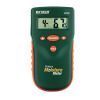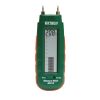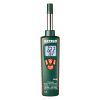Extech MO280-KW Water Damage Restoration Kit
The Extech Water Damage Restoration Kit is specifically designed for water damage restoration contractors.
Features
- Model MO210 pocket moisture meter measures building material moisture from 0.2 to 2%
- Model RH490 precision hygro-thermometer has 2% RH accuracy
- Model MO280 pinless moisture meter displays %moisture from 0 to 99%
- Free ground shipping
- Expedited repair and warranty service
- Lifetime technical support
- More
The Extech Water Damage Restoration Kit is specifically designed for water damage restoration contractors who monitor job site conditions, progress, and insurance company reporting. The kit is supplied in an attractive storage case that provides protectionand organization for the testers whenever they are needed. It includes:
Model MO280 pinless moisture meter for measurement depths to 0.75 inches below the surface with 10 different wood types to select from. Model MO210 pocket moisture meter measures wood moisture from 6 to 44% and building material moisture from 0.2 to 2%. Model RH490 precision hygro-thermometer has a less than 30 second RH response time with 2% RH accuracy and wide measurement ranges.
- (1) MO280 Pinless moisture meter
- (1) MO210 Pocket Moisture Meter
- (1) RH490 Precision Hygro-Thermometer
- (1) Storage case
In The News
Spring 2025 Environmental Monitor Available Now
In the Spring 2025 edition of the Environmental Monitor, we highlight partnerships across the world and the importance of collaboration between government agencies, universities, environmental groups, local communities, and other stakeholders. From great white shark research in Cape Cod to monitoring fisheries in Lake Erie, this latest edition underscores partnerships that connect stakeholders in a watershed through environmental data. With an emphasis on data sharing, a combination of real-time and discrete sampling keeps the public and partners informed of environmental conditions. Our writers also sought out science professionals dedicated to working with peers within and outside of the environmental sector.
Read MoreMonitoring Mariculture in the Gulf of Alaska
The mariculture industry in the Gulf of Alaska has been steadily growing in recent years, guided by ongoing research to help refine farm location and cultivation practices. A subset of aquaculture, mariculture focuses on rearing organisms in the open ocean. In Alaska, finfish farming is illegal, so most farms cultivate kelp, oysters, or a combination of the two. These small, locally operated farms started popping up in the Gulf of Alaska in the early 1990s, when shellfish farming first became legal. Kelp farming did not begin to catch on in the state until 2016. Many of the coastal areas that have grown interested in mariculture are historically commercial fishing communities.
Read MoreSupplying Seattle’s Drinking Water: Using Data Buoys to Monitor the Cedar River Municipal Watershed
Providing clean, safe, and reliable drinking water for the 1.6 million people in the greater Seattle area is a top priority for Seattle Public Utilities (SPU). With limited water supplies, SPU dedicates considerable resources to maintain its watersheds and mountain reservoirs. About 70 percent of Seattle Water comes from the Cedar River Municipal Watershed , and the other 30 percent comes from the South Fork Tolt River Watershed . [caption id="attachment_39574" align="alignnone" width="940"] Data buoy in Chester Morse Lake . (Credit: Kevin Johnson / Seattle Public Utilities) [/caption] Jamie Thompson, a fisheries biologist at SPU, monitors aquatic ecosystems centered on fish listed under the U.S. Endangered Species Act (ESA).
Read More









